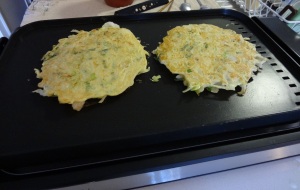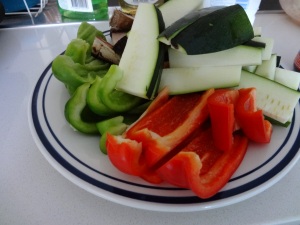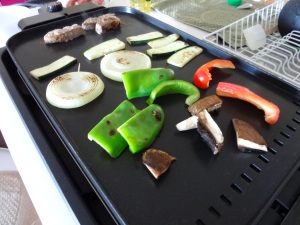Cooking and eating still happen chez Yusuke, just not much blogging.
Our stovetop was out of commission for a while, so a new grill/griddle was acquired.
Here are some action shots.
Yum.



Cooking and eating still happen chez Yusuke, just not much blogging.
Our stovetop was out of commission for a while, so a new grill/griddle was acquired.
Here are some action shots.
Yum.



Permalink Comments off

I’ve written about mabo dofu (that is, spicy tofu, also transliterated as mapo doufu) before, because it’s so darn tasty. The origins are Szechwanese, but it’s a very popular dish in Japan.
This version was extra-special, though, based on a recipe that Yusuke happened upon recently. Traditional mabo dofu is supposed to have ground pork, or possibly ground beef, but that just ruins everything. This is a lovely vegan* version of the classic dish, with mushrooms and natto instead of dead animals. Yes, natto: those slippery, pungent fermented soybeans. Along with the mushrooms, they provided a perfect texture and layering of umami.
Yusuke pretty much followed his usual recipe (quantities are approximate):
Lovely, filling texture and awesomely spicy taste.
*Yusuke used chicken stock, but veggie broth is fine, as is dashi stock.
Permalink Comments off

Here is another example of わふう パスタ (wafuu pasta)—that is, Japanese-style pasta. The possibilities are endless: see some examples here from Just Hungry. (Or Google it.)
To make this particular version:
Lightly saute sliced leeks, chopped mushrooms (portobello here, but could be shiitake), and canned tuna with:
Boil spaghetti in water with a bit of dashi and salt.
After the pasta is *mostly* cooked, add it to the skillet in which the leeks and mushrooms have been sauteing, along with some of the dashi-flavoured water from the pasta.
Cook everything a bit more and that’s it!
Permalink Comments off

Mmm, tasty pic. In this collaboration, I looked after sauteing white onions, mushrooms, and asparagus to fold into my dad’s expertly prepared thick, fluffy omelette.
Permalink Comments off

Shio-kōji is a popular item in Japanese kitchens of late, and hence in “western” ones as well. Yusuke and I had wanted to try it for a while, so he brought back a jar on a recent trip to Japan. We subsequently found it at a local Japanese grocery; restocking will not be too arduous!
So, what is shio-kōji? Short answer: kōji with salt.
So, what is kōji? Short answer: fungus.
Here is a longer answer from Makiko Itoh in the Japan Times. (Visit the rest of the article to read more.)
Kōji (Aspergillus oryzae) was probably domesticated at least 2,000 years ago. It is used to make sake, mirin, shōchū, awamori (an Okinawan beverage), rice vinegar, soy sauce and miso – all ingredients that define Japanese food. No wonder that it was declared the kokkin (national fungus) by the Brewing Society of Japan, and the genome was closely protected until 2005. Besides Japan, it is also used extensively in China and Korea to ferment and mature various foods.
To use kōji, spores are mixed into steamed rice (potatoes, wheat and soybeans are also used, depending on the purpose), then allowed to mature for a period of time in a warm environment, about 50 degrees Celsius. The kōji turns the starch in the rice into sugar (a process called saccharification) and releases a variety of fatty acids and amino acids including glutamate, the basis for the “fifth taste,” umami. This kōji-rice mixture is called kome-kōji.
When mixed with salt (shio, in Japanese), kōji is a very tasty cooking seasoning. It can be used for a variety of purposes, but among the most popular is marinating meat, fish, tofu, or veggies.
So far, we’ve used it to marinate salmon, as well as in a few veggie stir fries. Pictured above is the first attempt.
Yusuke began by stir frying the following in sesame oil:
When the veggies were nearly cooked, he stirred in about 2 tsp of shio-kōji and a sprinkling of black pepper. That’s it!
The concept of umami can be explained in many ways, but for me, it has to do with layers of taste and enhancing the natural flavours of the fresh veggies.


Permalink Comments off

Looks lovely, eh?
This was one of Yusuke’s weekend pasta creations.
The pasta of choice was spaghettini, imported from Italy, acquired from an Italian grocery. He cooked it to a perfect al dente.
To prepare the veggies, Yusuke started with TONS of garlic, to which he added four or so sliced portobello mushrooms and diced cherry tomatoes. Mid-way through the saute procedure, he sprinkled a tablespoon of sesame seeds into the mix.
At the end, he added the cooked pasta and tossed everything together. Last, raw green onions were added to the top!
He speculated that perhaps Italians wouldn’t recognize this as an Italian dish; instead, it’s definitely wafuu pasta—that is, Japanese style!
Permalink Comments off

This is a really old one. For the recipe, see http://blog.fatfreevegan.com/2008/02/vegetable-fried-quinoa.html
Permalink Comments off

This stir fry featured bok choy from our CSA basket, and it was so much more flavourful and firmer than what we get from the store. I love you, dear summer.
The procedure began with bok choy stems sauted in sesame oil. After it was cooked, Yusuke added the remaining bok choy greens and mushrooms.
Next he added some veggie bouillon dissolved in about 100 cc of water (Better than Bouillon brand) along with a tiny bit of sugar.
Cubes of silken tofu followed—careful not to break it!
He let everything simmer before adding katakuriko (Japanese potato starch).
That’s it. As Yusuke says, シンプル is best! (translation…)
On the side, we had miso soup with gorgeous green onions and egg (Yusuke’s favourite).
Permalink Comments off

This is a beautiful take on ごもくまめ (gomoku-mame), or “5 things and [soy]beans.” Or something like that. Often, the dish includes kombu or hijiki, mushrooms, konnyaku, gobo (burdock root), and renkon (lotus root)—the latter two to contribute a literally earthy taste.
Well, here we had to go with what was in our fridge, and we have five things including soybeans, but I think it still counts:
Yusuke anticipated this meal by soaking the soybeans in water for 24 hours or so. When it was time to start cooking, he drained them and added new water, bringing it to a boil. The beans were cooked for about an hour at low to medium heat, and he periodically scooped out the thin, bitter residue that comes off the beans.
Meanwhile, he soaked dried shitake for about 30 minutes. and then added the mushrooms, along with their soaking water, to the beans—enough water to cover them.
Next he added pieces of kombu that had been chopped into square-shaped pieces.
Then he added 1 tsp of sugar and 2 tbsp of soy sauce. Everything simmered for a while to reduce the water. Midway through the simmering stage, he added chopped carrots, and then almost at the very end came chopped snap peas.
Yummy and very filling.
Permalink Comments off